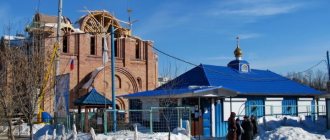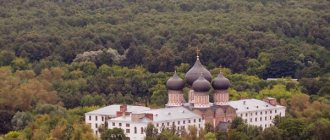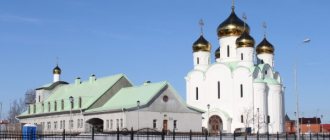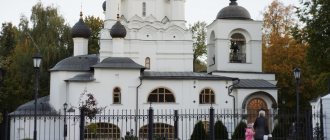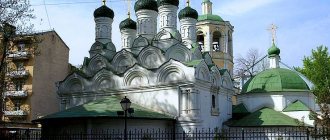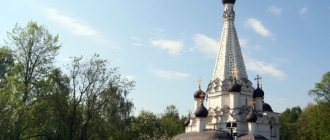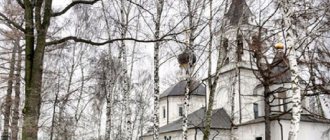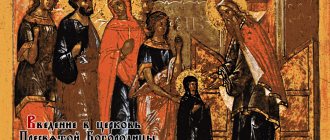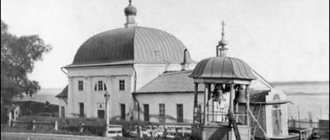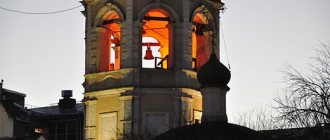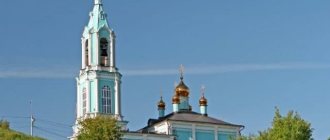Mir
Russia Moscow Temple of the Presentation of the Blessed Virgin Mary into the Temple in Veshnyaki (Moscow) Map is loading…
{"format":"leaflet","minzoom":false,"maxzoom":false,"limit":50,"offset":0,"link":"all","sort":[""], "order":[],"headers":"show","mainlabel":"","intro":"","outro":"","searchlabel":"\u2026 \u0441\u043b\u0435\ u0434\u0443\u044e\u0449\u0438\u0435 \u0440\u0435\u0437\u0443\u043b\u044c\u0442\u0430\u0442\u044b","default":"","import-annotation":false,"width ":"auto","height":"350px","centre":{"text":"","title":"""link":"","lat":55.74239899999999892088453634642064571380615234375,"lon": 37.81691599999999908732206677086651325225830078125,"icon":""},"title":"","label":"","icon":"","lines":[],"polygons":[],"circles":[ ],"rectangles":[],"copycoords":false,"static":false,"zoom":8,"defzoom":14,"layers":["OpenStreetMap"],"image layers":[] ,"overlays":[],"resizable":false,"fullscreen":true,"scrollwheelzoom":true,"cluster":false,"clustermaxzoom":9,"clusterzoomonclick":true,"clustermaxradius":80, "clusterspiderfy":true,"geojson":"","clicktarget":"","showtitle":true,"hidenamespace":false,"template":"","userparam":"","activeicon": "","pagelabel":false,"ajaxcoordproperty":"","ajaxquery":"","locations":[{"text":"\u003Cb\u003E\u003Ca href=\"/palomnik/%D0% A5%D1%80%D0%B0%D0%BC_%D0%92%D0%B2%D0%B5%D0%B4%D0%B5%D0%BD%D0%B8%D1%8F_%D0%B2% D0%BE_%D1%85%D1%80%D0%B0%D0%BC_%D0%9F%D1%80%D0%B5%D1%81%D0%B2%D1%8F%D1%82%D0% BE%D0%B9_%D0%91%D0%BE%D0%B3%D0%BE%D1%80%D0%BE%D0%B4%D0%B8%D1%86%D1%8B_%D0%B2_% D0%92%D0%B5%D1%88%D0%BD%D1%8F%D0%BA%D0%B0%D1%85_(%D0%9C%D0%BE%D1%81%D0%BA%D0 %B2%D0%B0)\» title=\»\u0425\u0440\u0430\u043c \u0412\u0432\u0435\u0434\u0435\u043d\u0438\u044f \u0432\u043e \u0445\u0440\u0430\u0 43c\ u041f\u0440\u0435\u0441\u0432\u044f\u0442\u043e\u0439 \u0411\u043e\u0433\u043e\u0440\u043e\u0434\u0438\u0446\u044b \u0432 \u 0412\u0435\u0448\u043d\u044f\ u043a\u0430\u0445 (\u041c\u043e\u0441\u043a\u0432\u0430)\»\u003E\u0425\u0440\u0430\u043c \u0412\u0432\u0435\u0434\u0435\u043d \u0438\u044f \u0432\ u043e \u0445\u0440\u0430\u043c \u041f\u0440\u0435\u0441\u0432\u044f\u0442\u043e\u0439 \u0411\u043e\u0433\u043e\u0440\u043e\u 0434\u0438\u0446\u044b\u0432\ u0412\u0435\u0448\u043d\u044f\u043a\u0430\u0445 (\u041c\u043e\u0441\u043a\u0432\u0430)\u003C/a\u003E\u003C/b\u003E","title":"\u042 5 \u0440\u0430\u043c \u0412\u0432\u0435\u0434\u0435\u043d\u0438\u044f \u0432\u043e \u0445\u0440\u0430\u043c \u041f\u0440\u043 5\u0441\u0432\u044f\u0442\u043e \u0439 \u0411\u043e\u0433\u043e\u0440\u043e\u0434\u0438\u0446\u044b \u0432 \u0412\u0435\u0448\u043d\u044f\u043a\u0430\u0445 (\u041c\u043e\u0441\u043a\ u0432\u0430)","link":"","lat":55.74239899999999892088453634642064571380615234375,"lon":37.81691599999999990873220667708665132522583007 8125,"icon":""}],,"imageLayers":[]}
55.74114; 37.825999
Russia, Moscow, Eastern administrative district, Veshnyaki district, 76th quarter of Veshnyaki district
Moscow
Russia
Telephone:
+7 (977) 337 33 31
Temple in honor of the Feast of the Entry of the Blessed Virgin Mary in Veshnyaki
- a modular type temple, built within the framework of the program of His Holiness, His Holiness Patriarch Kirill of Moscow and All Rus' for the construction of the required number of Orthodox churches for Moscow (commonly known as “Program-200”). The Temple of the Entry in Veshnyaki is the first temple in the Eastern Administrative District built under this program.
Architect, exterior decoration, architectural ensemble
The cross-domed 4-sided temple with 3 rounded altar projections on the eastern side was erected in the Old Russian style according to the design of the chief architect Nikitin K.V. Its height is more than 31 m, the total area is more than 1500 m2, the area of the prayer hall is more than 300 m2. The vaults and 5 domes on light drums are supported by 4 supporting columns with beautiful decorative decorations. The church building is surrounded on 3 sides by a low covered gallery.
Church of the Entry of the Blessed Virgin Mary in Butovo, diagram.
The entrances face three parts of the world except the east. The northern entrance is specially equipped for people with disabilities. The lower basement portion of the church building can be accessed from the outside or via stairs from the upper prayer hall. The brick walls of the cathedral are plastered and painted in delicate light colors. The building is decorated with beautiful window fragments, gilded valances, and ceramic compositions.
Forged gratings and massive entrance doors, cladding of individual parts with granite also decorate the temple. Its domes are covered with titanium and crowned with gilded crosses. This St. Vvedensky Cathedral in South Butovo is considered one of the most beautiful religious buildings being built in the Russian capital.
Repair and reconstruction of the temple, carried out in the first half of the 19th century
During the Napoleonic invasion and the associated fire that engulfed Moscow, the Church of the Presentation suffered significant damage, which is why, three years later, its restoration and reconstruction began, which lasted until 1837. During the work, which was led by the Moscow architect P. M. Kazakov, the shortcomings of the previous architectural project were taken into account.
In particular, to improve the illumination of the interior, several additional oval-shaped windows were cut into the walls of the building. The western part of the refectory vault was dismantled and re-laid, and inside it, two heavy quadrangular supports were replaced with light, round columns, with wide gaps left between them. In addition, a new iconostasis was installed, the author of the sketches was also the architect P. M. Kazakov. In this updated form, the Church of the Presentation existed until 1917, when the Bolsheviks’ rise to power led to the greatest tragedy in the history of Russian Orthodoxy.
History of construction
The Church of the Presentation of the Blessed Virgin Mary in South Butovo naturally appeared in the capital of new Russia next to the Nativity Church in Chernev, the celebration of the 300th anniversary of which took place at the end of 2010.
Vvedensky Church in Ivanovo
Several centuries ago there were functioning churches in the village of Chernevo and neighboring Ivanovsky. In the Nativity and Vvedensky churches at the beginning of the 19th century. Only one priest served - John Vozdvizhensky. Subsequently, his sons continued the work of their father, and his daughter married clergyman Nikolai Vorontsov, the last rector of these two churches.
The tragic fate of the Vvedensky Church and clergy in the 20th century.
After the revolution of 1917, a terrible period of persecution of Orthodox churches and their priests began. The Church of the Presentation in the village of Ivanovskoye was blown up in 1930, and 7 years later, priests Sergius Vozdvizhensky and Nikolai Vorontsov, archpriests Vasily Vozdvizhensky and Peter Ekaterinoslavsky, who had previously served there, suffered martyrdom by execution.
Decision and construction of a large cathedral in South Butovo
At the beginning of the 21st century. His Holiness the Patriarch blessed the initiative to build the Vvedensky Church near the Church of the Nativity in Chernev (Southern Butovo). On the feast of the Entry of the Blessed Virgin Mary, a solemn bishop's service took place in the Nativity Church in Chernev in the winter of 2010. After him, the clergy made a religious procession to the site of the future construction site, where they held sacred church ceremonies.
The consecration ceremony for the foundation of the cathedral took place on October 14, 2011, on the Feast of the Intercession of the Virgin Mary. It was conducted by the vicar of His Holiness Patriarch Irinarch.
Construction stages
The construction that began was initially carried out at a rapid pace and was carried out only with donations from parishioners: already in the spring of 2014, the lower part of the temple was consecrated, and a year later the main construction and installation work on the construction of the building was completed at the site. In 2016, the new temple became affiliated with the Church of the Nativity in Chernev. In 2022, by Decree of His Holiness the Patriarch, the Patriarchal Metochion of the South-Western Vicariate was established at the church under construction.
Due to a lack of funds, the completion of construction, interior decoration, and provision of the temple with heat, electricity and other communications took several years. Only in the past 2022 did artists begin to paint icons for the iconostasis. The cathedral is preparing for the rite of great consecration. Divine services are held regularly in the lower and upper churches.
Iconography of the Feast of the Entry of the Blessed Virgin Mary into the Temple
According to the research of J. Lafontaine-Dozogne, the image of the Introduction was originally known as part of the cycle of the life of the Virgin Mary. In monumental paintings it is found with c. (chapels of Joachim and Anna in Kyzylchukur, between the 7th century, the Virgin Mary and Saints John the Baptist and George in Goreme, early or 1st half century and (Cappadocia); Hagia Sophia in Kiev, 1037–1345; church Assumption of the Virgin Mary in Daphne, about 1100; Transfiguration Cathedral of the Mirozh Monastery in Pskov, 40s of the 12th century; Church of Our Lady Periveleptus in Ohrid (Macedonia), 1295; Church of Our Lady in the village of Susica near Skopje (Macedonia), end of the 13th century; Church of the Savior in the Žiča monastery (Serbia), 1309–1316; Church of Kraljevo (Saints Joachim and Anna) in the Studenica monastery (Serbia), 1314; Church of Martyr George in Staro Nagorichino (Macedonia), 1317– 1318; Church of the Assumption of the Virgin Mary of the Gracanica Monastery (Kosovo and Metohija), ca. 1320; Cathedral of the Hilandar Monastery on Mount Athos, 1320–1321; Chora Monastery (Kahrie-jami) in Constantinople, 1316–1321).
The introduction as part of the cycle of the life of the Virgin Mary can be located in the altar (St. Sophia Cathedral in Kiev, Church of the Assumption of the Virgin Mary in the Gracanica monastery), in the naos (Church of Our Lady Perivlepta in Ohrid, Kraleva Church in the Studenica monastery), in the paraclis (Church of the Savior in the Žiča monastery, Church of the Great Martyr George in Staro-Nagorichino), in the western compartment under the choir (Cathedral of the Mirozhsky Monastery), in the narthex (Church of the Assumption of the Virgin Mary in Daphne, Chora Monastery).
As a separate event, liturgically remembered and celebrated by the Church, the Introduction is depicted in the miniature of the Minology of Basil II [30], on the icons as part of the festive row of the iconostasis (fragment of the epistyle, 12th century, Vatopedi monastery; fragment of the epistyle, late 12th century, VMC monastery Catherine in Sinai; icon of the early 14th century, Hilandar Monastery; icon from the Kirillo-Belozersky Monastery, 1497, KBIAMZ), as well as in monumental paintings, where the composition is presented as an independent plot.
The iconography of the Introduction and the principles of the arrangement of this composition in the system of temple painting, its relationship with other scenes of the Mother of God and scenes of the earthly life of Christ correspond to the main themes of the chants of the holiday service. The most important of them is the theme of the Mother of God as an animated temple that contains the inconceivable God (“Today, the inconceivable temple, the Mother of God, is brought into the temple of the Lord.” 2nd stichera on the litia, tone 4). The composition represents a procession heading towards the temple in the form of a ciborium on thin columns, located inside a low fence. In the open (sometimes closed) doors of the fence, which resemble the royal doors of the iconostasis, the high priest Zechariah is bending towards the Mother of God, behind whom the church throne is visible. The image of open or closed gates correlates with the hymns of the service, which call the Mother of God “The Door of the Lord” (for example, “at the same time Zechariah cried out in wonder: To the Door of the Lord, I open the doors of the temple to You.” 1st stichera on the verse (Great Vespers) voice 5- y). This epithet of the Mother of God is based on the vision of the prophet. Ezekiel of the mysterious temple, through the closed doors of which the Lord enters and leaves (Ezek. 43. 1–7, 44. 1–4). This prophecy, which is read as parimia at the service of the Introduction, is a prototype of the ever-virginity of the Mother of God.
In monuments from the 13th century. at the head of the procession, following the Mother of God, Her parents are depicted, who present Her to the priest as a gift promised to God; behind Joachim and Anna are maidens holding burning candles in their hands. This structure of the composition corresponds to the theme of glorifying the Mother of God as a pure sacrifice to God (“You were brought into the temple, the All-Immaculate Pure... like a pure sacrifice” - 6th troparion of the 8th song of the 2nd canon). This sacrifice is understood as preparation, a prototype of the sacrifice that the Lord Himself will bring. It is no coincidence that in the system of temple painting the compositions “Introduction into the Temple” and “The Presentation of the Lord” are often compared. In the Church of the Savior on Nereditsa near Novgorod, 1199, these scenes are presented side by side on the northern wall, in the Church of St. Nicholas on Lipno Island (Novgorod), 1299, opposite each other, on the northern and southern walls of the vima. The large-sized compositions “Nativity of the Virgin” and “Introduction into the Temple”, occupying the most important places in the system of temple decoration, line up in one semantic row with the scenes “Nativity of Christ” and “Candlemas” (Church of St. Panteleimon in Nerezi (Macedonia), 1164 ; Church of St. Ahillius, Bishop of Larissa in Arilja (Serbia), 1296; Cathedral of the Nativity of the Virgin Mary in the Snetogorsk Monastery, 1313), as well as with passionate scenes (Church of St. Theodore Stratelates on the Stream in Novgorod, 80–90s. XIV century - The introduction is located under the Crucifixion on the eastern wall of the southern arm of the cross).
In the Palaiologan era, in the iconography of the Introduction, the emphasis shifts towards the Eucharistic understanding of the event. Joachim and Anna are depicted bringing up the rear of the procession (Kraleva Church in the Studenica Monastery), virgins with candles surround the Mother of God, who is also sometimes depicted with a candle in her hand. In the scene of the feeding of the Mother of God, sitting on the steps of the Holy of Holies and an Angel flying to Her from heaven, the Eucharistic significance of the episode is emphasized by the size of the loaf and the clear image of the cross on it (Hilandar). This theme is also dictated by the chants of the Service of Introduction: “The Virgin was raised faithfully with heavenly bread in the temple of the Lord, and you gave birth to the world the bread of life, the Word” (3rd stichera on praise, 1st tone). In the painting of the narthex of the Boyana Church (Bulgaria), 1259, the Mother of God in the scene of feeding with heavenly bread is represented standing next to the angel behind the throne in the Holy of Holies. In the painting of the altar vault of the Assumption Cathedral of the Moscow Kremlin, 1642–1643, the Introduction is depicted in the interior of the 5-domed temple, and the Old Testament Holy of Holies is presented as the altar of the New Testament temple, above the throne of which the Virgin Mary is depicted sitting on the steps, to whom an angel flies with a censer in her hand.
In general, the composition of the “Introduction to the Temple,” which has changed little over the centuries, could sometimes be noted for some peculiarities. Thus, on a Novgorod icon of the 14th century. (GRM) The introduction is shown in the interior of a 3-domed temple, under the arches of which lamps with burning candles hang. The figurine of the Mother of God is depicted against the background of a high black arched doorway. Behind the Mother of God on the right in positions of prayer are Joachim, Anna and the virgins, on the left behind Zechariah stands Joseph the Betrothed. The appearance of the image of rights. Joseph in the Novgorod icon, according to Lafontaine-Dozogne, may be due to the influence of the composition “The Betrothal of Mary”. For example, on the epistyle of the 12th century. (Vatopedi Monastery) the scenes “Introduction to the Temple” and “Betrothal of Mary” are located in a row. The tented form of the temple and the hanging lamps reveal similarities with the tented ciborium, decorated with lamps in the scene of the “Introduction into the Temple” in the painting of the Church of Panagia Arakos near Lagoudera (Cyprus), 1192. To the Church of the Assumption on Volotovo Field in Novgorod, 60s. XIV century, the traditional scheme of the Introduction is so inscribed in the space allotted to it that the group of maidens with candles turns out to be separated from the rest of the composition by a window opening. The expression of the images is emphasized by the pose of the infant Mary ascending the steps of the temple. This motif corresponds to the story of the proto-gospel that, to the surprise of those present, the Mother of God independently climbed the 15 high steps of the Jerusalem Temple.
The miniatures of 2 manuscripts of the Words of Jacob Kokkinovath, 1st half, are distinguished by special details in the depiction of the Entry and stay of the Mother of God in the temple, accompanied by a host of angels. XII century, [31].
Clergy, mentors
The clergy of the temple is represented by several clergy:
- The rector, Archpriest Igor Fedorov, is a native Muscovite born in 1962, graduated from the Moscow Theological Seminary in 2000, is an Honorary Citizen of the South Butovo district, and has several hierarchical and church awards.
- Full-time priest Anatoly Tambov was born in Moscow in 1984 and has a spiritual education.
- Full-time deacon Nikitin Alexander is a native Muscovite born in 1982. Graduated from MSTU. Bauman and the Orthodox Institute of St. John the Theologian.
In January 2022, Archimandrite Sergius died. He was a full-time priest at the temple.
Parish and choir
The parish of the Vvedensky Church is still very young, but the parishioners have done many good deeds so that a new large cathedral appears in their microdistrict next to the Church of the Nativity. The construction of the temple is carried out exclusively on donations from parishioners and the philanthropists they attract.
Despite the fact that the church is mostly built, donations are being collected to decorate the lower and upper parts of the temple, paint icons for 2 iconostases, and purchase the necessary church equipment. There is not yet a planned children's playground or a separate room for Sunday school on the territory. Parishioners actively participate in worship services, some of them sing in the church choir.
The parish organizes mass celebrations on major church holidays and children's sports events. The church is collecting items and funds to help elderly citizens, the disabled and large families. A parish newspaper is published regularly.
Social work, everyday life
The Church of the Presentation of the Blessed Virgin Mary in Butovo has been carrying out social work since the first days of construction. The parish social service works closely with the Helios Social Assistance Center. Through joint efforts, large families were provided with assistance in preparing their children for the start of the school year: with money from parishioners and benefactors, school bags with a full set of school supplies were purchased and donated to families.
During the pandemic, volunteers from the church’s social service delivered food and medicine to elderly parishioners in self-isolation.
Before the New Year, 11 large families received New Year's gifts for their children. The same gifts were given to the children staying at the “Mercy” house of the Doctor Lisa Foundation. Elderly parishioners and disabled people also received food packages for the New Year and Christmas holidays. Funds collected in the church were used to provide diapers for bedridden patients.
The social service of the church and the community of sisters of mercy at the Valaam Monastery in Moscow carry out joint actions, donating food to needy families and orphanages. In January, the parish held a charity event “Give Joy at Christmas.” Clothes and baby food were donated to large families. On Christmas Day, the church's social workers delivered gifts to the children of a boarding school in the town of Efremov, Tula region.
On the feast of Epiphany, volunteers helped pour holy water to the parish residents who came to the church, then delivered it to the disabled and sick who were unable to come to the church on their own.
Sunday School
The Sunday school at the temple has existed for several years. By studying there, children acquire the skills and abilities necessary for an Orthodox believer.
Timetable of classes:
| Group | Day of the week | Time | Item |
| Junior | Saturday | 12-00 – 12-30 12-40 – 13-10 | God's peace Choral singing |
| Average | Saturday | 12-00 – 12-30 12-40 – 13-10 | Choral singing God's Law |
| Older | Sunday | 12-00 – 12-30 12-40 – 13-10 | Church History Fundamentals of Christian Morality |
The schedule is subject to change, as detailed in the Sunday School app. Classes at the parish school are taught by experienced teachers.
There is an Evangelical circle at the temple, in which on Sundays from 18-00 there are distance learning classes on the study of the New Testament. They are led by Sunday School teacher Igor Aleksandrovich Tyurin. You can sign up for the group by calling: 8 (Natalia) and (Nikolai).
Silent Treasure Keepers
A very curious case dates back to this period. In 1948, to install new equipment in the workshop, it was necessary to break through a wall. When the workers delved deeper into the thickness of the brickwork, a vast cavity was suddenly discovered in it, in which three human skeletons and many different gold items, including coins of royal minting, were found.
Who were the people whose remains rested for many years in the church wall, and who owned the treasures found there, remained unknown. At least information about this was not made public. The workers were ordered to keep quiet, which they did, fearing the undesirable consequences of excessive talkativeness. Only during the years of perestroika did this case become public knowledge, but even then it did not receive any convincing explanation.
Patronal holidays
The patronal feast day in the Holy Presentation Church in Chernevo (Southern Butovo) is celebrated on December 4, the day of the Entry into the Temple of the Blessed Virgin Mary, which is one of the twelfth holidays of the Orthodox Church. The Divine Liturgy in honor of the holiday is led by Archpriest Igor Fedorov.
Then a sermon is preached about the significance of this event in the life of every Orthodox Christian. The holiday ends with a meal, during which parishioners have the opportunity to communicate and get to know each other better.
Interesting facts about the temple
The Church of the Entry of the Blessed Virgin Mary in Butovo already has a history in which there are significant events:
- The first Decree of Moscow Mayor Sergei Sobyanin concerning the construction of Orthodox churches in the capital was the Decree of October 28, 2010 on the allocation of a land plot of 0.9 hectares for the construction of the Cathedral of the Presentation of the Blessed Virgin Mary in Chernev.
- In the lower part of the Vvedensky Church, services began to be held in the spring of 2014, and 3 years later the rite of small consecration of the lower temple was held.
- The first Divine Liturgy in the upper chapel of the Holy Vvedensky Church took place in December 2016. In the same year, the temple became affiliated with the Church of the Nativity in Chernev.
- Social workers of the Nativity and Vvedensky churches in Chernev, Sergei and Tatyana Chelkin, with the blessing of Theophylact, vicar of the Holy Patriarch, were awarded letters of gratitude for their many years of work and care for the residents of South Butovo. The award was presented in March 2022 by Rector Igor Fedorov.
- The 76-year-old church cleric Archimandrite Sergius, who died on January 2 of this year, served in the Holy Vvedensky Church for almost 2 years. Before that, he was a cleric of the Russian Ecclesiastical Mission in Jerusalem for 8 years. The parishioners respected and loved Father Sergius; the bright memory of him will remain in their hearts.
History[edit]
After the necessary approvals (carried out by the Financial and Economic Administration of the Moscow Patriarchate), the Russian Orthodox Church was allocated a plot of land. A project for a temple for 500 people was developed and approved (the author of the project is the MosProekt-3 organization), and the necessary public hearings were held on this construction in the building of the Veshnyaki district government.
Construction began after a prayer service on August 27, 2011 (see photo gallery) and, with God’s help, continues successfully. A rector of the church has been appointed, and the formation of a parish community is underway. On the territory allocated for the temple complex, weekly prayer services are held - every Sunday at 13.00.
What's in the area
In South Butovo, where the Church of the Entry of the Blessed Virgin Mary is located, there are many places of interest, religious monuments, beautiful parks and estates. It has its own special culture.
Neighborhood:
- Church of the Nativity on the street. Chernevskaya, 1 - a cultural heritage site, since 1993 it has been an active Orthodox church. Rector Igor Fedorov, who now serves as rector of the nearby Holy Vvedensky Church, spent 17 years putting a lot of effort into restoring the Nativity Church and building a Sunday school building. During the reconstruction of the temple, white stone tombstones from the graves of the Tarakanov family, the founders of the estate and the Nativity Church, were found and installed.
- Next to the former Chernevo estate, Yuzhnobutovsky Park is located on an area of 140 hectares (the Buninskaya Alleya and Gorchakovskaya Street metro stations are located on its territory). The park's reservoirs (6 ponds and the Koryushka River, former Chernevka) cover almost 20 hectares. An ecological trail was created along the fortified banks, recreation areas and more than 12 km of bicycle paths appeared. The park has a green theater, an amphitheater, a summer theater and a dance floor. More than 30 species of trees and shrubs, totaling almost 45 thousand, were planted on its territory.
- The historical monument “Garden of Memory” in Butovo is located a little further from the Holy Vvedensky Church. This is the largest memorial to the victims of Stalin's repressions. In 1937-38, more than 20,700 people of 73 nationalities, all religions and classes were shot at the Butovo training ground. These were adults and children, men and women. Their names are immortalized on memorial plaques. In the stone temple, which is part of the memorial, there is a museum with things and documents of the victims, their photographs. On the Day of Remembrance of the New Martyrs who suffered in Butovo, patriarchal services are held annually in the open air.
Temple returned to the ownership of the Russian Orthodox Church
The process of perestroika, which swept the country in the last decade of the last century and affected all areas of its life, radically changed the government's attitude towards religious issues. The return to the Church of movable and immovable property illegally taken from it has begun. Among other objects, believers received at their disposal the Vvedensky Church, which had been restored by that time. The schedule of services, which replaced official signs on its doors indicating the state institutions located inside, testified most eloquently to the changes that had come.
Information for pilgrims
Pilgrimage to Russia is in demand among Orthodox believers. In South Butovo, pilgrimage trips are organized by the social service of the Church of the Nativity of Christ in Chernev (tel. +7 495 714 69 54) and the Pilgrimage Center at the Church of the Vladimir Icon of the Mother of God (tel., head Elena Alexandrovna Lisitskaya).
Major pilgrimage centers in Moscow:
- Pilgrimage Center of the Moscow Patriarchate – tel.+7.
- International Pilgrimage Center "Pokrov" - tel. +7;.
- "Makovets" - tel..
- "Origins" - tel.
Fire of 1737 and subsequent restoration work
One of the first disasters experienced by the temple was a fire that engulfed it in 1737 and caused significant damage to both the walls of the building and its interior decoration. During the restoration work, which lasted for several years, a new element was added to the overall architectural composition, which became a multi-tiered bell tower, which has survived to this day without significant changes. It is characteristic that in its appearance it is close to the bell tower of the Church of the Nativity of John the Baptist, erected in 1741 on Varvarka, one of the streets in the center of Moscow.
Where is it located, what is in the surrounding area, how to get there
The Vvedensky Church is located in Moscow on Yuzhnobutovskaya Street, property 62-66. Coordinates: 55.535825, 37.526474.
Tel.;. Temple website: hramvbutovo_ru
The Moscow metro stations closest to the temple are:
- St. Gorchakova.
- Buninskaya alley.
- Admiral Ushakov Boulevard.
Take the Butovskaya metro line to the “Ulitsa Gorchakova” station or the “Buninskaya Alleya” station. The temple is located 10 minutes from them. walking. You can use public transport and go to the stop closest to the temple, “4th Microdistrict of Southern Butovo” (60 m from the temple). Not far from the temple on the same street there is the Milady salon, a service center, a hardware store, and a medical store.
The Church of the Presentation of the Blessed Virgin Mary in Chernevo (South Butovo) restored historical justice and perpetuated the memory of the priests who served in the Church of the Presentation, destroyed in the first years after the 1917 revolution, and who suffered martyrdom during the period of Stalinist repressions. Moral values are eternal, they are timeless.
Architectural features of the temple
According to art historians, the Vvedenskaya Church, built in Moscow, is a striking example of the style that is commonly called Moscow Baroque. This is evidenced, in particular, by the abundance and nature of decorations used in the exterior decoration of the building. The creators of the temple decorated it with decorative kokoshniks crowning the walls, picturesque groups of columns located in the corners of the main quadrangle, as well as lush and very elegant window frames.
They also did not skimp on creating a huge number of small details that harmoniously fit into the overall appearance of the building. It is known that due to Peter I’s temporary ban on the use of iron in roofing work, the roof of the Church of the Presentation had a special covering made of colored tiles and white stone, which gave it a festive look. By 1770, it had become quite dilapidated, and since the ban had been lifted by that time, it was replaced with ordinary sheet iron.
